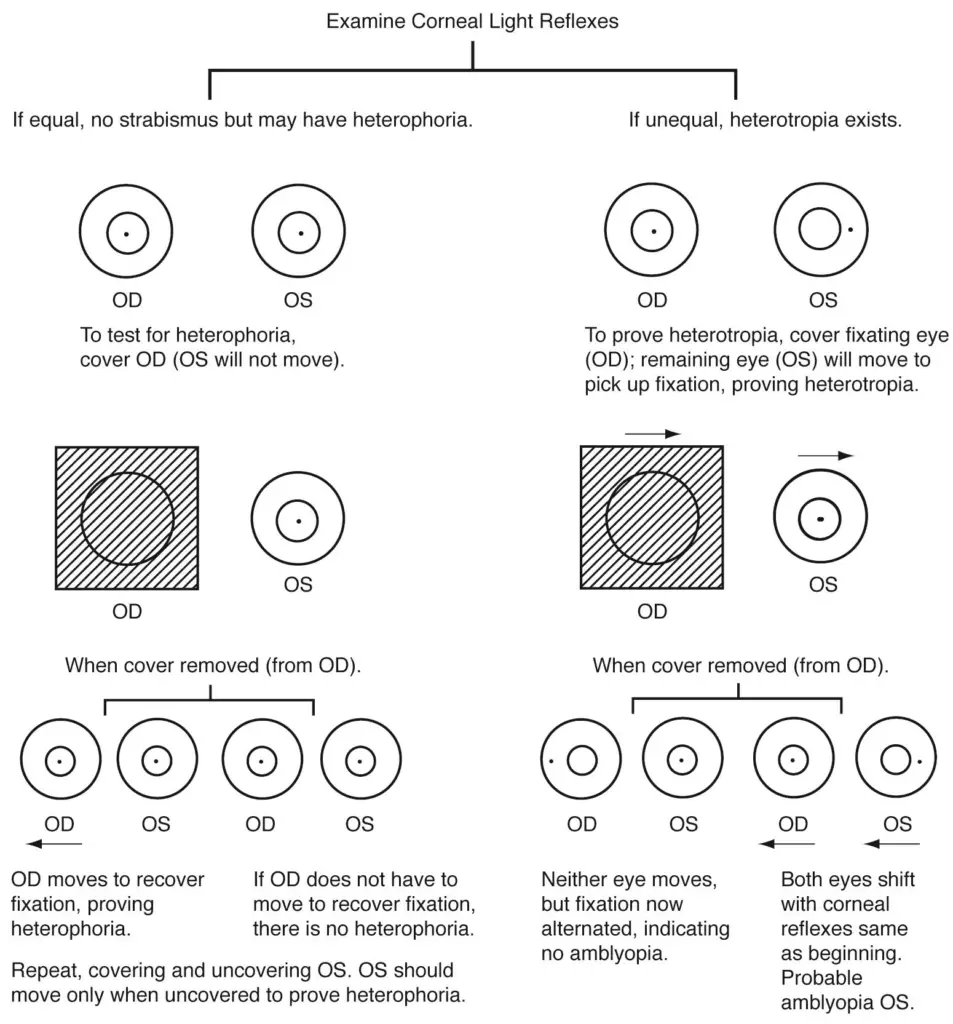Testing Children for Accommodative and Convergence Disorders: An Educational Guide for Optometrists
As optometrists, testing children for binocular vision (BV) conditions, particularly accommodative and convergence disorders, requires a meticulous and methodical approach. These conditions, though often subtle, can significantly impair a child’s ability to learn and function. In this comprehensive guide, we delve deeper into exam strategies, diagnostic tools, and management approaches to ensure thorough evaluations and effective interventions.

Image credit-visionscience academy
Exam Strategies: Testing Accommodative and Convergence Disorders in children
A cooperative and attentive patient is pivotal for accurate BV testing. Fixation and accommodation must be well-controlled to avoid misleading results. For instance, a child with esophoria at near and an AC/A ratio of 9/1 who under-accommodates due to distraction during a cover test might appear orthophoric or even exophoric.
To maintain engagement and ensure adequate fixation:
- Use engaging targets. Ask relatable questions like, “What color is Spider-Man’s face?” or “Can you see Spider-Man’s two eyes?”
- Verify fixation. Slightly move the target side-to-side (1-2 cm) and observe the pursuit movement, which requires both fixation and accommodation.
- Create a positive atmosphere. Explain the process in relatable terms, such as calling the test “gym class for the eyes,” to encourage participation.
- Adapt techniques. If the child struggles with subjective tests, switch to objective methods like using prism bars for vergence ranges.
Target selection is critical. High-contrast, small targets with fine detail encourage accurate fixation and accommodation. Sticker targets and smartphone videos can be particularly effective for pediatric patients.
Diagnostic Techniques: A Systematic Approach to testing Accommodative and Convergence Disorders in children
To accurately assess accommodation and convergence, employ a variety of tests suited to the child’s age and developmental level:
- Cover Test (CT):
- Perform at distance and near with and without corrective lenses.
- Ensure the child has sufficient time to fixate before moving the occluder.
- Use small, accommodative targets to avoid underestimating esophoria.
- Near Point of Convergence (NPC):
- Use both accommodative and non-accommodative targets.
- Normal ranges for children: 5 cm break/7 cm recovery.
- Dynamic Retinoscopy:
- Evaluate the accommodative lag or lead.
- Useful for detecting accommodative insufficiency or excess.
- Binocular Accommodative Facility (BAF):
- Test with ±2.00D lenses.
- Norms for children (ages 8-12): 5 cycles per minute (cpm) ± 2.5.
- Vergence Facility Testing:
- Use 12 BO/3 BI prism flips at near.
- Norms for children >10 years: 15 cpm ± 2.

Managing Pediatric BV Conditions
The pediatric optometrist and Pediatric Optometry
Case Example: Refractive Esotropia with Hyperopia
A 6-year-old with the following results:
- Uncorrected: OD +5.00 DS, OS +7.00 DS; Cover Test: 15 IAET distance, 18 IAET near.
- Corrected: OD +1.00 DS, OS +1.00 DS; Cover Test: 5 IAET distance, 8 IAET near.
This child demonstrates refractive esotropia, resolved with full hyperopic correction. Treatment tips:
- Older children need partial prescriptions for better distance VA.
- Preschoolers can tolerate higher hyperopia prescriptions due to their arm-length focus.
- Use a near add for adaptation, reducing it incrementally as binocularity improves.
Special Considerations for Strabismus and Esotropia
- Strabismus:
- Determine frequency (constant vs. intermittent) and laterality (alternating vs. unilateral).
- Constant deviations in infants require timely intervention to preserve stereopsis.
- Use Fresnel prisms or consider surgery only if refractive correction fails to improve alignment.
- Near Esophoria:
- Evaluate compensatory vergence ranges using BI prisms.
- High AC/A cases benefit from near adds, while accommodative insufficiency may require vision therapy.
Comprehensive Exam Sequencing
In pediatric BV exams, efficiency and thoroughness are crucial. Follow these minimum recommended tests by age group:
| Test | School-aged | Preschool | Infant |
|---|---|---|---|
| Visual Acuity | Snellen | Picture chart | Fix and follow |
| Stereoacuity | Randot | Lang or Randot | Lang |
| Cover Test | Letter targets | Sticker targets | Sticker targets |
| Refractive Status | Retinoscopy | Retinoscopy | Retinoscopy |
| NPC (Accommodative) | Letter targets | Sticker targets | Sticker targets |
Treatment Options for Common BV Conditions
- Accommodative Insufficiency:
- Treatment: Near add, vision therapy.
- Goal: Reduce accommodative effort.
- Convergence Insufficiency:
- Treatment: Vision therapy to build positive fusional vergence.
- Esotropia:
- Use plus lenses with a near add.
- Refer for therapy or surgery if needed.
- Exotropia:
- Overminus lenses may improve alignment.
- Gradually taper over time.
Final Thoughts: Be Vigilant and Comprehensive
Pediatric patients may not report symptoms because they might not understand what “normal” vision feels like. By asking targeted questions about symptoms like headaches, blurred vision, or difficulty reading, and incorporating thorough BV testing into every pediatric exam, optometrists can make a significant impact on a child’s visual and academic future.
Educating ourselves on updated strategies and techniques ensures we can provide the best care for our young patients, fostering a lifetime of healthy vision.
Follow us in Facebook
Discover more from An Eye Care Blog
Subscribe to get the latest posts sent to your email.

You must be logged in to post a comment.